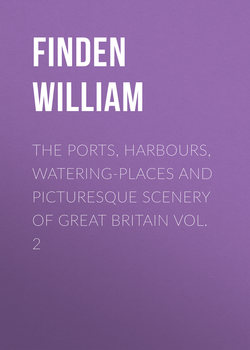Читать книгу The Ports, Harbours, Watering-places and Picturesque Scenery of Great Britain Vol. 2 - Finden William - Страница 11
BEAUMARIS, ANGLESEA
Оглавление"I have stood gazing on Snowdon and Plinlimmon, the vale of Clwyd, the straits of Menai – lake, river, sea, and land – till they seemed of themselves to say, Stranger, well mayst thou gaze! we merit thine admiration – we are of God!"
Beaumaris is finely situated on the picturesque banks of the Menai, where it opens into the bay, and presents many attractions derived from its historical monuments, its natural advantages, and modern improvements. As the principal town in the island and county of Anglesea, it has long been a place of fashionable resort, and being at the same time the borough and market-town, it is a scene of considerable activity, cheerfulness, and animation. It is in general well built; particularly one street, the houses of which are large and commodious, and of superior design and execution. Of the original wall by which it was once enclosed, considerable portions still remain – sufficient to demonstrate, by their massive strength and durability, the iron features, and the no less iron policy of feudal times. The castle – erected by Edward the First, and now an imposing ruin close to the town – covers a large space of ground, but stands too low to produce that effect upon the spectator which it would have done had it, like so many of its cotemporaries, occupied an isolated and commanding position. It is surrounded by a deep fosse, with an entrance between two embattled walls on the east, with round and square towers. The gate opens into a spacious court, measuring fifty-seven yards by sixty, with four square towers, and an advanced-work on the east, called the Gunner's Walk. Within these was the keep – the body of the castle – nearly square, having a round tower at each angle, and another in the centre of each façade. The area forms an irregular octagon, of the dimensions above named. In the middle of the north side is the hall, twenty yards long by twelve broad, with two round towers, and several others about the inner and outer walls, built of a bluish stone intermixed with square stones, which produce a rather novel and pleasing effect.
There appears to have been originally a communication round the whole buildings of the inner court by means of a gallery two yards broad, and which still remains nearly entire. In various recesses in different parts of the sides of this gallery are square apertures, which appear to have had trap-doors or openings into a dungeon beneath. The two eastern towers served also as dungeons, with a dark and narrow descent to each – sufficiently characteristic of the dark and despotic purposes to which they were applied. On the east side of this building are the remains of a very small chapel, arched and ribbed with painting and intersecting arches; also some Gothic pilasters and narrow lancet-headed windows, and various compartments, with closets constructed – after the manner of those times – in the centre of the massive walls.
When Edward the First built the town, and erected it into a corporation, he endowed it at the same time with various lands and privileges of considerable value, in order to secure more firmly his possessions in the island, and changed its name from Bonover to Beaumaris, in allusion, it is supposed, to its low but pleasant situation. He caused also a canal to be cut, in order that vessels might be brought up close under the battlements to discharge their cargoes, as the iron mooring-rings affixed to the walls clearly indicate.
The church, which forms a prominent feature in the picture of Beaumaris, is a spacious and very elegant structure, having a lofty square tower, visible at a great distance, and presenting in all its proportions and compartments a fine specimen of ecclesiastical architecture. The other public buildings consist of the county-hall, the town-hall, the free-school, and the custom-house; each possessing, in an eminent degree, every ornament and accommodation befitting buildings of their class and destination. The view from the green commands a striking prospect of the most interesting portion of the Menai Strait, bounded in the distance by the Caernarvon mountains, which gradually overtop each other till they unite in the majestic Snowdon, whose summit – now belted with clouds, and now glittering in the sunshine – asserts his claim to undivided empire as "Sovran" of the British Alps.
With respect to trade, Beaumaris can hardly be said to enjoy any exclusive advantages: the vessels belonging to the port are generally hired by neighbouring merchants and others, who have trading connexions with Liverpool and other ports on the English and Irish sides of the Channel. The bay, though not spacious, is safe and commodious, and affords shelter and good anchorage for vessels that take refuge here in tempestuous weather. The town has a weekly market on Wednesdays, and three annual cattle fairs in February, September, and December. During the season it is much resorted to as bathing-quarters, and has everything to recommend it as a summer residence. A steam-boat plies regularly between this and Liverpool, thereby affording every facility to visitors, and presenting in the passage a rich succession of beautiful, picturesque, and sublime scenery, which successively invites and fascinates the eye of the spectator.
